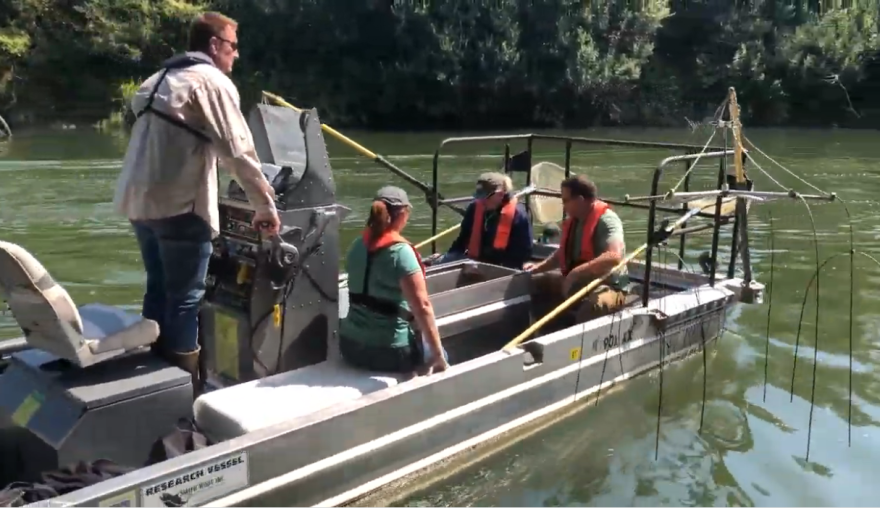Note: You’re going to hear two different pronunciations for the same word. “Coquille” [pronounced “koh-KWEL”] is the official name of the Native American tribe, while “Coquille” [pronounced “koh-KEEL”] is the name for the neighboring town and river. You can learn why there’s a difference here.
Now on to the story: The Coquille Tribe based in southern coastal Oregon are fighting to save their prized fish, the Chinook salmon. And their efforts recently took a shocking turn.

On a special, electrified boat coursing through the Coquille River, a small team of Coquille tribal members and personnel from the Oregon Department of Fish & Wildlife (ODFW), gazed over the rippling green waters, nets in hand. They scooped up fish drifting belly up, stunned from the electrical field that emanated from the front of the craft.
“It’s a really great collaborative project where we are removing smallmouth and some striped bass from the Coquille River,” said Helena Linnell, the biological planning and operations manager for the Coquille Tribe.
Linnell was part of the crew that was collecting, measuring, and recorded the fish.
Nearby, Morgan Davies of the ODFW extended an octopus-like array of cables that form the special apparatus that zaps the invasive bass. I asked how many they can average in a day’s work.
“Uhm, a good day, we’re about 500,” he laughed. “It depends where you’re at on the river and what the tide level is. And every bass that we take out of the river is one less bass eating Chinook when they’re going out.”
The bass have plagued the Coquille River for over a decade, biologists say. They feed on young Chinook salmon, which has decimated their numbers.
ODFW biologist Gary Vanderohe said the electro-fishing initiative is just one of many efforts to reduce the bass, which many officials believe were introduced into this waterway illegally.

“We don’t know for sure. There are smallmouth bass in neighboring watersheds, so most likely somebody caught ’em in another watershed and brought them over here. About 2018, the fall Chinook population took a really hard nose dive.”
A very hard nose dive indeed, comparing numbers within the decade. Coquille tribal chairwoman Brenda Meade told KLCC that ODFW’s research showed that in 2010 there were 30,000 returning Chinook salmon, but only 275 in 2019.
“That’s a 99 percent decrease in return numbers for our salmon,” said Meade. “We immediately declared an emergency. It’s a very inhospitable environment for our salmon today.”
Other factors besides invasive bass include pollution, river and ocean conditions, and insufficient brood stock.
Recently, the Coquille Tribe helped net six salmon that were deposited in the Bandon Hatchery’s holding pond. They’ll stay there until their bodies are ready to spawn. And beginning last year, the ODFW introduced a spearfishing season to reduce bass numbers in the Coquille waterways.

“This is going to be an ongoing effort for decades to come,” acknowledged Meade. “If we can take some of the invasive species outta there to give those salmon a fighting chance that will be a success, but it’s quite possible that we can never completely eradicate them.”

The electrofishing operation wrapped up in mid-September, but not after crews took out nearly 5,000 smallmouth and striped bass (those fish, by the way, were literally for the birds…all were sent to the Cascades Raptor Center, in Eugene, where they fed recovering hawks and falcons.)
Electro-fishing will resume in June 2022. Coquille Tribal elder Bill Murphy said their latest efforts will hopefully mean more Chinook salmon coming back to the Coquille River in the coming months.
“When we harvest the salmon we honor them by returning the bones, so that they make sure the fish return every year,” Murphy said.
“And we live in harmony with the fish, and when the fish aren’t doing good we’re not doing good. So trying to eradicate these predators seems to be the answer.”
Copyright 2021, KLCC.



